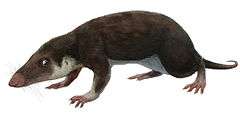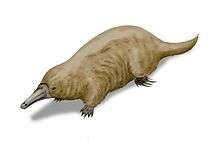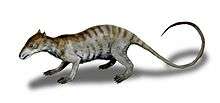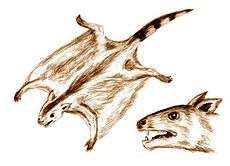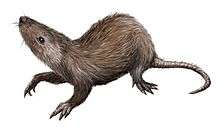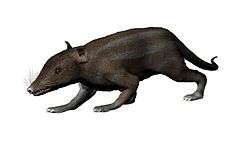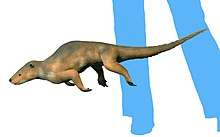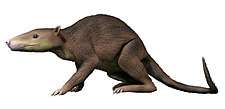Theria
Theria (/ˈθɪəriə/; Greek: θηρίον theríon, wild beast) is a subclass of mammals[2] amongst the Theriiformes (the sister taxon to Yinotheria). Theria includes the eutherians (including the placental mammals) and the metatherians (including the marsupials).
| Theria | |
|---|---|
| A human (placental) holding two koalas, (marsupial), representing the two extant infraclasses of therian mammals. | |
| Scientific classification | |
| Kingdom: | Animalia |
| Phylum: | Chordata |
| Class: | Mammalia |
| Clade: | Tribosphenida |
| Subclass: | Theria Parker & Haswell, 1897[1] |
| Infraclasses | |
Characteristics
Therian mammals give birth to live young without a shelled egg. This is possible thanks to key proteins called syncytins, which allow exchanges between the mother and its offspring through a placenta; even rudimental ones such as the marsupials. Genetic studies have suggested a viral origin of syncytins through the endogenization process.[3]
The marsupials and the placental mammals evolved from a common therian ancestor that gave live-birth by suppressing the mother's immune system. While the marsupials continued to give birth to an underdeveloped fetus after a short pregnancy, the ancestors of placental mammals gradually evolved a prolonged pregnancy.[4]
Therian mammals no longer have the coracoid bone, contrary to their cousins, monotremes.
Pinnae (external ears) are also a distinctive trait that is a therian exclusivity, though some therians, such as the earless seals, have lost them secondarily.[5]
Evolution
The earliest known therian mammal fossil is Juramaia, from the Late Jurassic (Oxfordian stage) of China. However, molecular data suggests that therians may have originated even earlier, during the Early Jurassic.[6]
Taxonomy
The rank of "Theria" may vary depending on the classification system used. The textbook classification system by Vaughan et al. (2000)[7] gives the following:
|
Class Mammalia
|
In the above system Theria is a subclass. Alternatively, in the system proposed by McKenna and Bell (1997)[8] it is ranked as a supercohort under the subclass Theriiformes:
|
Class Mammalia
|
Another classification proposed by Luo et al. (2002)[9] does not assign any rank to the taxonomic levels, but uses a purely cladistic system instead.
See also
References
- ITIS Standard Report Page: Theria
- Myers, P., R. Espinosa, C. S. Parr, T. Jones, G. S. Hammond, and T. A. Dewey. "Subclass Theria". Animal Diversity Web.CS1 maint: multiple names: authors list (link)
- Cornelis, G.; Vernochet, C.; Carradec, Q.; Souquere, S.; Mulot, B.; Catzeflis, F.; Nilsson, M. A.; Menzies, B. R.; Renfree, M. B.; Pierron, G.; Zeller, U.; Heidmann, O.; Dupressoir, A.; Heidmann, T. (2015). "Retroviral envelope gene captures and syncytin exaptation for placentation in marsupials". Proceedings of the National Academy of Sciences of the United States of America. 112 (5): E487–E496. doi:10.1073/pnas.1417000112. PMC 4321253. PMID 25605903.
- Ancient “genomic parasites” spurred evolution of pregnancy in mammals
- SUMIYAMA K; MIYAKE T; GRIMWOOD J; STUART A; DICKSON M; SCHMUTZ J; RUDDLE FH; MYERS RM; AMEMIYA CT (2012). "Theria-Specific Homeodomain and cis-Regulatory Element Evolution of the Dlx3–4 Bigene Cluster in 12 Different Mammalian Species". Journal of Experimental Zoology Part B: Molecular and Developmental Evolution. 318 (8): 639–650. doi:10.1002/jez.b.22469. PMC 3651898. PMID 22951979.
- Hugall, A.F. et al. (2007) Calibration choice, rate smoothing, and the pattern of tetrapod diversification according to the long nuclear gene RAG-1. Syst Biol. 56(4):543-63.
- Vaughan, Terry A., James M. Ryan, and Nicholas J. Czaplewski. 2000. Mammalogy: Fourth Edition. Saunders College Publishing, 565 pp. ISBN 0-03-025034-X
- McKenna, Malcolm C., and Bell, Susan K. 1997. Classification of Mammals Above the Species Level. Columbia University Press, New York, 631 pp. ISBN 0-231-11013-8
- Luo, Z.-X., Z. Kielan-Jaworowska, and R. L. Cifelli. 2002. In quest for a phylogeny of Mesozoic mammals. Acta Palaeontologica Polonica, 47:1-78.
